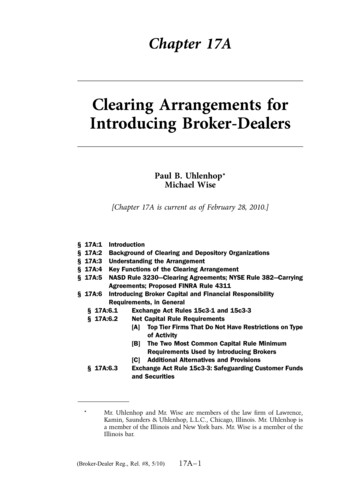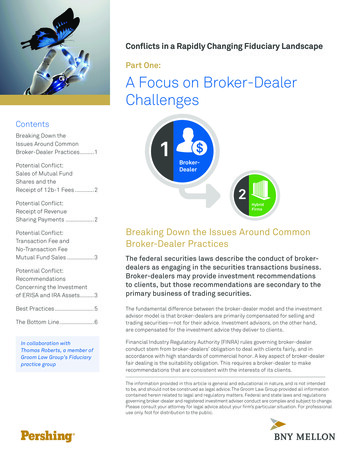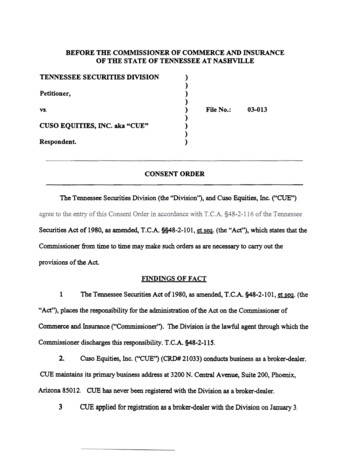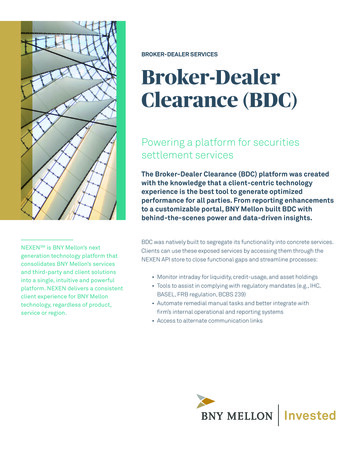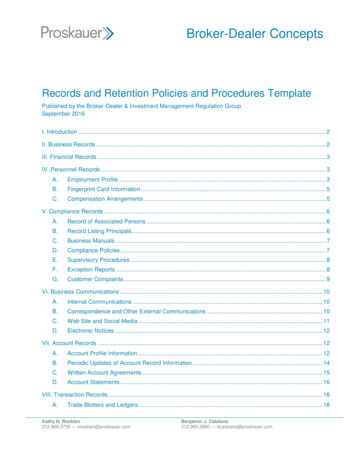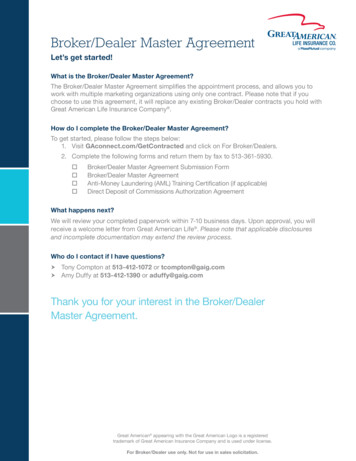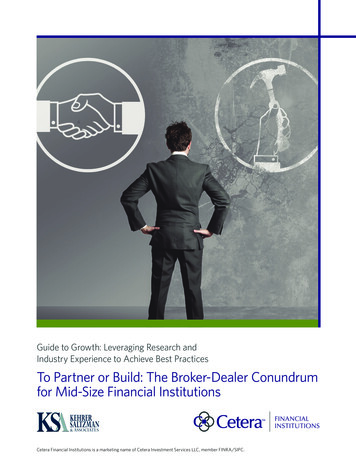
Transcription
Guide to Growth: Leveraging Research andIndustry Experience to Achieve Best PracticesTo Partner or Build: The Broker-Dealer Conundrumfor Mid-Size Financial InstitutionsCetera Financial Institutions is a marketing name of Cetera Investment Services LLC, member FINRA/SIPC.
Overview/BackgroundWith the investment and insurance business recently exhibiting stronger financial performance,many banks and credit unions are again considering the choice between partnering with a thirdparty broker-dealer (TPM) or establishing, or maintaining, their own introducing broker-dealer.This discussion typically comes up for financial institutions with retail deposits between 5 billionand 10 billion. But we are continually seeing firms on either side of that range, and in both modelsinitiating or revisiting this important discussion.Evaluating whether to partner or build is much morethan a decision simply to rent or buy.2For use with financial professionals only.
Current LandscapeAmong the 49 retail banks with more than 10 billion in non-public deposits, which are essentiallythe deposits of households and businesses, that offer investment services, at the end of 2010,only one of these banks outsourced its broker-dealer to a third party. On the other hand, amongthe 211 banks in the 1 billion to 5 billion deposit range that provide investment services, only 4(less than 2 percent) have their own broker-dealer. For the banks with between 5 billion and 10billion in retail deposits, 22 percent provide investment services through their own broker-dealer,63 percent outsource this function, and the remaining 7 (15 percent) are not yet in the investmentservices business.Figure 1 Banks Offering Investment Services by Size of BankNon-Public DepositsMore than 10 billion 5 to 10 billion 1 to 5 billion 500 million to 1 billionNumber of banks5249359499Banks offeringInvestment Services4942211211Banks with ownBroker-Dealer481140Source: Federal Deposit Insurance Corporation (FDIC)Evaluating whether to partner or build, however, is much more than a decision simply to rent or buy.The model chosen will determine much of what a program will look like to clients and drive manyother decisions about the business.Keeping this in mind, the following are some of the critical issues to consider for each model.Key ResourcesThe TPM model provides the benefits of leverage and scale for many critical functions, e.g., supervision, compliance, technology, fixed income trading and product support and due diligence. Theresources of a TPM are generally highly skilled because pooling spreads the cost of the resourcesover more advisors and a larger revenue base. Pooled resources also tend to have deeper experience because they are exposed to a wider range of situations and circumstances. The trade-off isthat each institution shares the time and commitment of those resources, so that while they areproficient, each institution’s business is not their only focus. Bringing these functions in-houseprovides the opposite qualities. The institution will probably be able to afford only less seasonedresources, but they are 100 percent focused on the firm’s business.3For use with financial professionals only.
Supervision and ComplianceSupervision and compliance are an important area of trade-off, as the responsibilities for thesefunctions have increased dramatically in recent years. When operating in the TPM model, most ofthese functions are provided by the third-party partner, while becoming a broker-dealer will requiremeaningful staffing and resources in these areas. The individuals needed to fill these positions arein great demand and are more prevalent in markets that have a larger investment industry presence.So filling these positions can be both difficult and costly.In addition, there will need to be systems in place to enable these roles to perform their function, e.g.,email review and archiving, trade suitability review and surveillance. The cost of these systems hascome down in recent years as more competition has entered the market, but they can still be costlyboth to acquire and operate. The best approach for programs starting their own broker-dealer is tocontract with a provider instead of buying a system outright or ideally to utilize an in-place systemprovided by a clearing broker, as this is more of a turnkey solution and can be negotiated beforecontracting with the clearing firm.Operating and supervisory procedures will need to be designed and codified for every step of eachprocess, tested, and their use and effectiveness documented. Licensing and registration will alsoneed to be taken on, although this is typically a smaller effort than some of the other key responsibilities. All this and more will be the responsibility of the Chief Compliance Officer (CCO), who willbe a member of the firm’s executive management team. In addition to a CCO, a staff of at least twowill be required, plus an administrative person for licensing and registration.Clearly the hurdles to establishing a broker-dealer have increased with regulatory costs. Between2007 and 2010, the latest Kehrer-LIMRA benchmarking data available, the cost of complianceand supervision increased by about one-third. Recent regulatory changes and the prospect of theimplementation of a fiduciary standard are expected to push compliance and supervision expenseseven higher.4For use with financial professionals only.
Figure 2 Trends in Compliance ExpensesCompliance and supervision expenses as a percent of investment and insurance services %20092010Source: Kehrer-LIMRA Annual Financial Institution Investment Program Benchmarking SurveyEconomies of ScaleHow do economies of scale impact these expenses? There are very few participants in the KehrerLIMRA Benchmarking Survey with annual investment and insurance revenue below 10 million. Butby pooling data across four years and normalizing the data to the average compliance expense forthe most recent year, we are able to have sufficient observations for analysis.Based on the Kehrer-LIMRA Benchmarking Survey, compliance and supervision expenses tend to decline with the size of the financial institution’s broker-dealer, although not dramatically. Complianceexpenses as a percent of revenue for firms with between 10 million and 50 million in revenue arenine percent lower than in smaller firms. For firms with between 50 million and 100 million ininvestment and insurance revenue, compliance and supervision expenses are another 14 percentlower. Compliance expenses fall another eight percent for the very largest bank broker-dealers.These modest reductions in expenses with the scale of the firm are largely the result of the laborintensive nature of compliance and supervision. Larger firms are able to leverage technology andspecialization of labor to achieve some cost savings, but the savings are not very large.5For use with financial professionals only.
Figure 3 Compliance Expenses by Size of Firm in Millions in RevenueAverage compliance expense as a percent of investment and insurance revenue, normalized to 20102.5%2.0%2.3%2.1%1.5%1.8%1.65%1.0%0.5%0.0%less than 10 10 to 50 50 to 100more than 100Source: Kehrer-LIMRA Annual Financial Institution Investment Program Benchmarking SurveyHowever, there are additional complementary considerations. The timeline to become a brokerdealer is uncertain, costly and can take from six months to a year. And there may be some liability intransferring accounts from the TPM to the new broker-dealer. Using a TPM may contractually protecta financial institution from client, regulatory and legal risk, but that does not absolve the financialinstitution completely. It still has reputation risk, especially in cases where the institution disagreeswith how its third-party broker-dealer handles an issue.OperationsIn moving from a TPM to an in-house broker-dealer, processing the business creates the biggestneed for additional resources. In this area, however, automation has created some efficiencies. Cashiering is more electronic, and new accounts can be opened by the advisor or sales assistant, butthere will still be labor-intensive work to perform for retirement plans and overall service issues, suchas ACAT transfers. The staffing for this tends to be less costly than compliance and more readilyavailable, and many times can be found from within the financial institution itself. Some investmentservices units operating in a TPM model also have a group of light operations staff that can form thecore of the staff needed to fill these positions. A team of three is a starting point to provide backupcoverage and enable specialization.In addition to processing equity trades and packaged products such as annuities and mutual funds,the broker-dealer will also need to provide fixed income trading. Many of the fixed income tradestoday are placed through online entry systems, but there are still virtues to having fixed income traders, especially when it comes to municipal bonds or for help in constructing portfolios.6For use with financial professionals only.
With an in-house broker-dealer, there is more flexibility to either use the parent financial institution’s Capital Markets’ desk, the clearing broker’s facility, or the broker-dealer’s own trading desk.There can be revenue-sharing hurdles in working with Capital Markets, but the benefit is leveraginganother area of the bank and taking advantage of product opportunities that are a close fit with theclient demographics. The product mix of a program and overall market interest rates will drive thevolume and resource requirements for this resource.Despite the efficiencies created by technology, operations expenses nevertheless increased between2007 and 2010. The cost of processing the investment and insurance business as a percent of revenue increased 20 percent over the four years.Figure 4 Trends in Operations ExpensesOperations and clearing expenses as a percent of investment and insurance services 0%20072008Source: Kehrer-LIMRA Annual Financial Institution Investment Program Benchmarking SurveyEconomies of ScaleNonetheless, there are dramatic economies of scale in operations expenses. Financial institutionbroker-dealers with between 10 million and 50 million in investment and insurance servicesrevenue have average operations expenses, as a percent of revenue, that are 35 percent lowerthan firms with less revenue. The expense ratio for operations continues to decline with increasingrevenue until the firm reaches 100 million in revenue. The largest firms have the same ratio of operations expense to revenue as bank or credit union broker-dealers with 10 million to 50 millionin revenue. This is likely due to the desire to customize services like cash management accountswith proprietary deposit alternatives and the ability to bundle accounts to support fee thresholdsand waivers. In addition, the larger financial institution broker-dealers attract higher-producingadvisors who have greater client service demands and need more labor intensive and specializedresources to support the product set they sell.7For use with financial professionals only.
Figure 5 Operations Expenses by Size of Firm in Millions in RevenueOperations expenses as a percent of investment and insurance services revenue20%15%15.9%10%10.4%8.0%5%0%10.3%less then 10 10 to 50 50 to 757.1% 75 to 100more than 100Source: Kehrer-LIMRA Annual Financial Institution Investment Program Benchmarking SurveyIn moving from a TPM to an in-house broker-dealer,processing the business creates the biggest need foradditional resources.8For use with financial professionals only.
Technology, Communications andData ManagementExpenditures on technology and communications in financial institution broker-dealers, includingamortized capital expenses, fluctuated from 2007-2010, with no apparent trend. The reduction inthe share of revenue consumed by technology expenses in 2010 is partly attributable to expensecutbacks and project delays in the wake of the challenging revenue environment of late 2008 and2009. On the other hand, the sharp increase in the share of revenue spent on technology in 2009is attributable to the twin forces of scheduled technology buys for that budget year coupled with asharp decline in investment and insurance services revenue.Figure 6 Trends in Technology & Communications Expenses as a percent of RevenueTechnology and communications expenses as a percent of investment and insurance services 7200820092010Source: Kehrer-LIMRA Annual Financial Institution Investment Program Benchmarking SurveyEconomies of ScaleThe expense ratio for technology and communications actually increases with the size of the financial institution broker-dealer, and exceeds 2 percent of revenue for firms with more than 100million in revenue.9For use with financial professionals only.
Figure 7 Technology & Communications Expenses by Size of Firm in MillionsTechnology and communications expenses as a percent of investment and insurance services s than 10 10 to 50 50 to 100more than 100Source: Kehrer-LIMRA Annual Financial Institution Investment Program Benchmarking SurveyAgain, customization to meet a financial institution’s particular requirements is the driver behindincreased costs. The largest financial institution broker-dealers might want more customized tools.This desire can manifest itself in financial professional-facing tools, such as a customized landingpage on the workstation that shows all relationships each client has within the bank or credit union.Other areas that may require customization include the need for communications that require a dailydata feed from the clearing broker-dealer that is used to populate the financial institution’s website,the development of a customized client-facing website, or reporting requirements that enable afinancial institution to categorize data in the manner that is prevalent in its operating structure (e.g.,showing each piece of business and tying it to each advisor, branch and employee referral source).Financial institutions considering starting a broker-dealer generally would have to rely on the bank’sor credit union’s Information Technology unit to support the broker-dealer’s technology. The investment services business would have to compete with the institution’s priorities for IT resources,and would often not be first in line. And the institution’s IT staff would not be as experienced orknowledgeable about the technology needed to support broker-dealer operations as the IT staff atthe TPM. The TPM is focused just on growing the broker-dealer business in its partner institutions.10For use with financial professionals only.
Product Support & Due DiligenceThe products themselves are going to be comparable in either model, since the TPMs have a fullproduct menu. The difference is who is going to provide general training and support to the advisorsand product due diligence. TPMs universally provide this function. Interestingly, this tends to be oneof the more important reasons why financial institutions opt to create their own broker-dealer, as theinstitution views products and the application of those products as the “value add” they can bring.Going the in-house broker-dealer route will require some form of resource to evaluate and generateresearch, portfolio models, and recommendations and provide help desk support on mutual funds,annuities, fee-based advisory and alternative products. If the firm plans to focus on advisory business,it will also need field coaches to support that initiative, educating advisors and helping them analyzetheir book to identify clients to transition from transactions to managed money.The due diligence function has become increasingly important as regulators have focused on thesuitability of product recommendations and investors may be stretching their risk tolerance insearch of better yields.It is easier to identify and hire to fill this position than the supervisory and compliance roles. Staffingfor this role depends on the size and the scope of the firm’s business, but the lead product manageris another member of the executive management team.Product support is a function that benefits from economies of scale. A product manager in a brokerdealer with 5 million in revenue would cost 2 percent to 3 percent of revenue. At 10 million, theexpense ratio falls to 1 percent to 2 percent of revenue, and to less than 1 percent of revenue at 20million in revenue.Product MixThe product mix of a program is a critical variable in choosing the broker-dealer model. Two productsrepresenting the different ends of the spectrum are fixed annuities and advisory business. If the firm’scurrent and future revenue is weighted to the annuity side of the spectrum, the processing costs arenominal in either model (less than 5 percent of revenue), so there is little financial reason to shift ineither direction. If the business looks more like an advisory model with a large recurring componentfrom fee-based business, then there might be more opportunity to save on product costs (expensescloser to 20 percent) by internalizing some of the costs in an in-house broker-dealer.11For use with financial professionals only.
Advisor ProfileWhat is true for product mix is amplified for advisors. If the advisors are selling primarily a packagedproduct set of fixed annuities, variable annuities and mutual funds, their client base has less interest in who is processing the trade. However, in many cases the advisors and their clients that arefocused on advisory business come from a proprietary broker-dealer environment, and so will havemore comfort operating in that model. This applies not only to the advisors an institution has today,but those it intends to recruit. This trend may have already shown up in the makeup of the currentstaff of advisors.On the other hand, a TPM provides recruiting resources, experience, and networking that may enable the financial institution to recruit better advisors.The in-house broker-dealer model focused on advisory business might be easier to integrate withthe financial institution’s wealth management unit, encouraging joint sales and teaming betweenwealth management and investment services. There can be a perception that being a broker-dealerdemonstrates a higher commitment from the financial institution to the business, and this impactshow both clients and advisors view the financial institution. This perception often seems to havemore influence in selecting which model to use than many more tangible criteria.Sales ManagementGenerally sales management is employed by the financial institution’s investment services unitwhether the institution partners with a TPM or manages its own broker-dealer, although in somebanks or credit unions, the sales managers are employed by the third-party partner. Having salesmanagement as part of the broker-dealer makes a financial institution feel that it has a more directand vested interest in the success of the business.The coverage range for sales managers is typically from 15 to 30 Series 7 advisors reporting to eachmanager. The production level of the advisors, their experience, their geographic location, productsophistication and the sales managers experience all factor into the coverage determination, butwe would target 20 to 25 as an optimum coverage in normal circumstances. A TPM may have anadvantage in being able to recruit sales managers, but there are many candidates available in themarketplace to fill these roles.12For use with financial professionals only.
Executive ManagementThe TPM brings intangible management resources to the partnership: experience in managing allthe components of an investment and insurance service business inside a financial institution—legal, compliance, technology, trading, cash management, processing, clearing, advisor recruitment and development. The TPM also has expertise in working out integration issues with bankor credit union management, and brings an understanding of best industry practices. A financialinstitution could recruit that kind of expertise, but it is available from the TPM to support a lessexpensive executive team or a homegrown candidate from within the institution.Minimum StaffingThe in-house broker-dealer will require a Series 27 licensed chief financial officer to sign off on thefinancial statements and file the required reporting. This responsibility can be outsourced. Beyondthat, the broker-dealer will need finance and accounting support for general income statement andbalance sheet entries.The broker-dealer will also require a CCO, a position in high demand today. The CCO will needto be a principal with a Series 24 and be on board early in the process to help develop the necessary compliance infrastructure, including staffing, systems and procedures such as email reviewand retention, and trade suitability and surveillance. The CCO needs to test these systems andprocedures prior to going live with broker-dealer transactions, and be able to demonstrate to theregulators on an ongoing basis that the procedures are being followed.In addition to Executive Management, an internalized broker-dealer will require the aforementionedpositions in sales management, accounting, trading, marketing, operations, technology and others.13For use with financial professionals only.
Financial ConsiderationsWe can bring together the various expense elements of financial institution broker-dealers of varioussizes to examine the financial trade-off between outsourcing to a TPM and creating a broker-dealer.Figure 8 Institution Broker-Dealer Expenses by Size of FirmAnnual RevenueLess than 10 million 10 million to 50 million 50 million to 75 .0%Technology1.6%1.7%1.9%Product Management1.5%0.5%0.2%Total Percentof Revenue21.3%14.7%11.9%These estimates are sensitive to a product mix, and would be higher for a heavily advisory-orientedbusiness and lower if the business is primarily packaged products. For banks and credit unions witha typical product mix and less than 10 million in revenue, the cost to staff, deploy systems andmanage within a broker-dealer environment will be considerably more than the typical revenue haircut retained by the TPM partner. Even above 10 million in annual revenue, outsourcing to a TPM iscompetitive with building one’s own broker-dealer.Differences in profit margin between the two models generally do not come into play until the businesses reach the higher end of the revenue range. All financial institutions are in need of bettermargins, but considering that investment and insurance services make up mid-single digits of totalfinancial institution profit at best, some do not view the profit they throw off as meaningful enoughto undertake the additional expense and risks of operating their own broker-dealer. Others are willing to trade off a lower current margin by becoming their own broker-dealer with the hopes of highergrowth. Even when a firm gets to a point where the profit margins are the same in the two models,the financials will look different to the parent financial institution. This is because the net income inthe broker-dealer model is earned with lower fixed costs and without the same head count burdenas the in-house broker-dealer model.14For use with financial professionals only.
Capital and Equity RequirementsThe financial institution will have to set aside capital and equity to support the broker-dealer. Theservice lines and method of clearing will determine the firm’s net capital requirement, but the minimum capital requirement for an introducing broker-dealer (which clears business through a clearingbroker) is 25,000, but a broker-dealer operated by a financial institution usually requires a minimumof 250,000 in capital. It is not unusual for FINRA to require the broker-dealer to initially maintain 1.2times the standard capital requirement for the firm’s operations until the firm reaches the break-evenlevel. The capital position of the financial institution is sometimes taken into account in determiningthe capital requirement of its broker-dealer.A more significant figure to consider is the equity required to manage the business. According to aninternal study of industry broker-dealers with operating revenue ranging from 37 to 107 million,the equity required to maintain the business averaged approximately 25% of operating revenue orupwards of 24 million.In either case, the capital and equity required to support the broker-dealer would not be available tosupport the growth of other business of the financial institution.LiabilityAs with any enterprise, operating a broker-dealer creates liability. This liability can arise from improperactions of sales people and other employees, operating the firm outside regulatory requirements, customers who claim their investments were unsuitable (regardless of whether or not they in fact were),investment products that failed to perform as represented, and the ordinary errors and omissions thatoccur in the course of day-to-day business. When a financial institution establishes a broker-dealer, ittakes on all the regulatory exposure and liability of business previously done by the third broker-dealer.This additional exposure is a principal reason why many financial institutions prefer to continue topartner with a third-party broker-dealer, so that this liability is shared.The monetary costs of these penalties can be ameliorated with E&O insurance, but the availability,coverage, and cost of insurance become more problematic the more complex and demanding theregulatory environment.Over and above the legal fees and penalties from regulatory enforcements is reputational risk to theinstitution, and the distraction of executive management by bad publicity and managing arbitrationsand enforcement actions.15For use with financial professionals only.
Growth ProspectsAn important variable tied closely to financial considerations is the anticipated growth of the investment services business. If an institution has a reason to expect much higher than normal annualgrowth, it might be better for them to convert to their own broker-dealer sooner rather than later.Conversions are never easy, but affecting a fewer number of clients now might be viewed as advisableif there is a true long-term view that the financial institution and its investment services business willbe much larger in the future because of acquisitions. The opposite might be true for those institutionsthat are shrinking in order to be more profitable.Another consideration for some institutions is the valuation of their investment services business.Recognizing that with either model the financial institution owns the clients, the TPM business isviewed from a market valuation perspective as simply revenue or fee income. The in-house brokerdealer business, however, is considered in the valuation of the overall financial institution enterprise,contributing to the accompanying multiple. This might be because the financial institution that hasgone the in-house broker-dealer route has made more of an investment in people, systems andpositioning, or because it is more likely to retain the advisor if the financial institution were sold.Creating and Managing a Broker-DealerCreating a broker-dealer involves submitting to an additional regulatory structure, with its regulations processes, audits, and capital requirements.New Member ApplicationUnique to starting a broker-dealer is the regulatory filing. The NMA will require as attachmentsseveral procedural documents, the most important of which is the WSP (Written SupervisoryProcedures) because it will have to cover the entire scope of the firm’s activities, its principals,their assigned responsibilities, control steps, etc. Even a modest application can run to 140 pagesbecause it deals almost as much with what the firm will not do (and how steps are put in placeto detect that) than what it would do. The actual posting of the information can be tedious andtime-consuming. Templates for creating the NMA are available, but the process of developing thebusiness plan and completing the application will consume a few hundred hours of executive time.The application process requires much lead time and provides a taste of the ongoing level of regulations that will need to be followed. The process can be lengthy. From the time the applicant paysthe initial fee ( 3,000), it has one year to complete the application. From the time FINRA deemsthe application complete, it has 180 days to make a decision. From start to finish the process can becompleted in about six months with fast tracking, but the process can drag on.More significant than the creation of the document is the ability to follow exactly what is outlinedin the voluminous document once it has been created. Putting the appropriate procedures in place,training and testing will all need to be incorporated into the business plan and executed during thetransition to the new broker-dealer.16For use with financial professionals only.
Business PlanThe business plan is a mandatory part of the registration process. The business plan specifies business lines, professional staffing, marketing strategy, infrastructure, and capital commitment. FINRAwill be looking for a cohesive realistic document with detailed financial pro formas for 24 months. Italso focuses on marketing and time to break even, with sufficient capital to exist until then.Hybrid ModelsFor those institutions considering changing their broker-dealer model, a hybrid arrangement witha TPM or clearing firm might be the right
party broker-dealer (TPM) or establishing, or maintaining, their own introducing broker-dealer. This discussion typically comes up for financial institutions with retail deposits between 5 billion and 10 billion. But we are continually seeing firms on either side of that range, and in both models initiating or revisiting this important .


